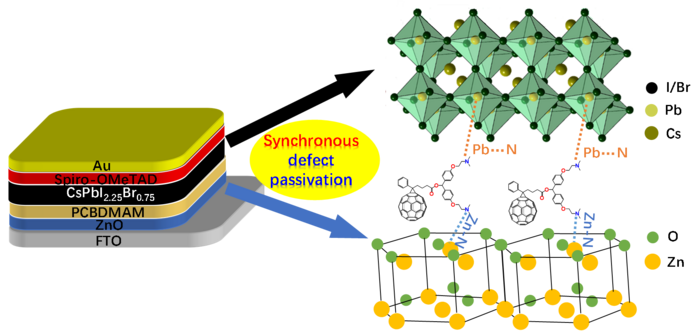Solar cells are a critical component to the transition to renewable energy sources, and enhanced power conversion efficiency (PCE), or amount of power captured with a given amount of sunlight, increases the practicality of solar power in a society with high energy demands. Perovskite solar cells that use all-inorganic perovskite light-absorbing materials are more thermally stable than organic-inorganic hybrid counterparts, but suffer from lower PCE. Researchers have overcome this hurdle in all-inorganic perovskite solar cells (PSC) by adding a conductive fullerene-derivative interlayer to enhance PCE and thermal stability.

Credit: Nano Research Energy, Tsinghua University Press
Solar cells are a critical component to the transition to renewable energy sources, and enhanced power conversion efficiency (PCE), or amount of power captured with a given amount of sunlight, increases the practicality of solar power in a society with high energy demands. Perovskite solar cells that use all-inorganic perovskite light-absorbing materials are more thermally stable than organic-inorganic hybrid counterparts, but suffer from lower PCE. Researchers have overcome this hurdle in all-inorganic perovskite solar cells (PSC) by adding a conductive fullerene-derivative interlayer to enhance PCE and thermal stability.
All-inorganic perovskite solar cells have the advantage of increased thermal stability, which is critical for the longevity of solar cells, but lack in PCE compared to solar cells made with organic-inorganic hybrid counterparts. A group of leading material scientists recently investigated the use of an interlayer to ameliorate the defects found in all-inorganic PSCs. In PSCs, layers of perovskite, a material that conducts energy when exposed to light, are susceptible to problems in morphology, energy level mismatches and electron traps that decrease electron transport and overall solar cell efficiency. Introducing an interlayer of a fullerene derivative called bis-dimethylamino-functionalized fullerene derivative (PCBDMAM), sandwiched between the perovskite and the electron transport layer, remedies these deficiencies, increasing electron transport and PCE improving temperature stability.
The team published their findings in the May, 16 issue of Nano Research Energy, published by Tsinghua University Press.
“High-efficiency PSC devices are mostly based on organic-inorganic hybrid perovskite light-absorbing materials, which are intrinsically volatile and thermally unstable due to the existence of organic cations, resulting in poor thermal stability of PSC devices and hampering large-scale commercialization of organic-inorganic hybrid PSCs,” said Shangfeng Yang, lead principal investigator of the study and professor at the CAS Key Laboratory of Materials for Energy Conversion at the University of Science and Technology of China in Hefei, China. “To enhance the PCE of [all-inorganic perovskite] PSCs, interface engineering has been extensively applied and demonstrated to be effective in promoting electron transport by improving film morphology, lowering the energy level mismatch and passivating the antisite traps in perovskite,” said Yang.
“By using different types of interlayers including small molecules, polymers, inorganic compounds, 2D perovskite layers as well as fullerene and its derivatives, defect passivations of all-inorganic PSCs have been accomplished,” said Yang. In particular, the team used PCBDMAM as an interlayer between an all-inorganic perovskite layer and a zinc oxide electron transport layer. In this application, the PCBDMAM was spin-coated onto the zinc oxide surface as a conductive surface coating to mitigate the film morphology and other defects of the all-inorganic perovskite layer, improving the overall thermal stabilities of both the zinc oxide and perovskite layers and increasing PCE from 15.44% to 17.04%.
The successful transition to renewable energy sources depends, in part, on robust solar cells that can efficiently convert solar energy to electricity and withstand environmental extremes. Direct recombination, in particular, is a limiting factor in the efficiency of solar cells and presents a significant challenge for the research team and other material scientists. Direct recombination is the process by which electrons, created by light in the solar cell, and holes encounter one another and recombine. This recombination emits a photon, reversing electricity production in the solar cell.
The research team will continue to overcome hurdles to improve the functionality and lifespan of solar cells to make solar energy production more reliable and less expensive. Future challenges include further mitigating solar cell defects, including direct recombination, by altering the composition, concentration and application of solar cell layers to optimize temperature stability and efficiency in a commercially viable and cost-efficient way.
Other contributors include Yanbo Shang, Pu Wang, Lingbo Jia, Xingcheng Li, Weitao Lian, Peisan Qian, Tao Chen and Yalin Lu from the CAS Key Laboratory of Materials for Energy Conversion in the Anhui Laboratory of Advanced Photon Science and Technology from the Department of Materials Science and Engineering at the University of Science and Technology of China in Hefei, China; and Muqing Chen from the School of Environment and Civil Engineering at Dongguan University of Technology in Dongguan, China.
This work was supported by the National Natural Science Foundation of China (51925206, U1932214, 52172053).
##
About Nano Research Energy
Nano Research Energy is launched by Tsinghua University Press, aiming at being an international, open-access and interdisciplinary journal. We will publish research on cutting-edge advanced nanomaterials and nanotechnology for energy. It is dedicated to exploring various aspects of energy-related research that utilizes nanomaterials and nanotechnology, including but not limited to energy generation, conversion, storage, conservation, clean energy, etc. Nano Research Energy will publish four types of manuscripts, that is, Communications, Research Articles, Reviews, and Perspectives in an open-access form.
About SciOpen
SciOpen is a professional open access resource for discovery of scientific and technical content published by the Tsinghua University Press and its publishing partners, providing the scholarly publishing community with innovative technology and market-leading capabilities. SciOpen provides end-to-end services across manuscript submission, peer review, content hosting, analytics, and identity management and expert advice to ensure each journal’s development by offering a range of options across all functions as Journal Layout, Production Services, Editorial Services, Marketing and Promotions, Online Functionality, etc. By digitalizing the publishing process, SciOpen widens the reach, deepens the impact, and accelerates the exchange of ideas.
Journal
Nano Research Energy
DOI
10.26599/NRE.2023.9120073
Article Title
Synchronous defect passivation of all-inorganic perovskite solar cells enabled by fullerene interlayer
Article Publication Date
16-May-2023




